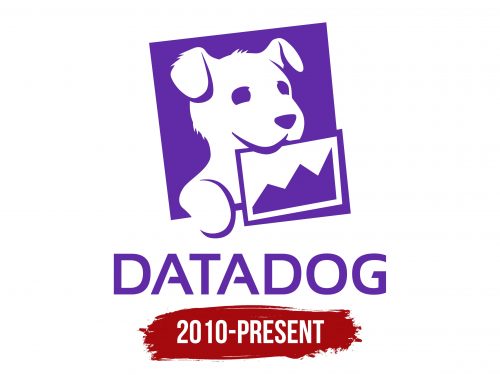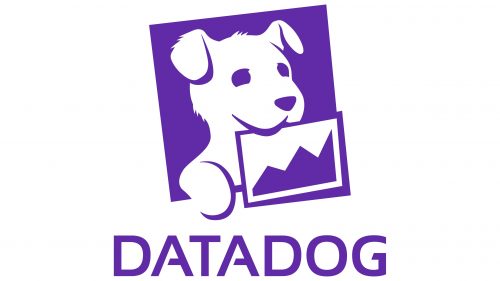The Datadog logo creates the image of a loyal guardian who manages data and provides reports to the owner as needed. This emblem brings digital programs to life, leaving a positive impression on the client.
Datadog: Brand overview
Two seasoned engineers, Olivier Pomel and Alexis Lê-Quôc, founded Datadog 2010 to tackle monitoring and analytics issues in the quickly developing cloud computing industry. Due to their vast backgrounds in the technology sector, the founders recognized the inadequacy of the monitoring tools available at the time, given the increasing complexity of today’s infrastructures.
Pomel and Lê-Quôc started working on their product in New York. They wanted to build a platform that could combine information from several sources and offer a thorough analysis of IT infrastructure performance. They aimed to create a tool that could quickly adjust to the ever-evolving technological environment.
The enterprise launched its initial product version in 2012. This initial version was primarily concerned with basic analytics and server monitoring. Despite its limited functionality, the product’s creative approach to data visualization and user-friendly interface soon garnered notice among the tech community.
The company completed a sizable fundraising round in 2013. The firm grew its team and sped up product development with the help of a $6.2 million investment from Index Ventures and other investors. Additionally, the brand increased its industry presence and actively promoted itself in the market by attending tech conferences with the support of this money.
The enterprise added more features and capabilities to its platform over the following few years. One of the most important steps in extending the firm’s capabilities for monitoring cloud infrastructure was the introduction of integration with AWS in 2014. As a result, users of the tool acquired a more profound understanding of their AWS-based apps.
A major extension of the platform’s capabilities occurred in 2015. With the growing popularity of containerization technologies like Docker, adding support for container monitoring was especially crucial. Additionally, the business unveiled application tracing, allowing developers to monitor particular application components’ functionality.
The company raised $94.5 million in a fresh fundraising round in 2016. Thanks to this funding infusion, the firm increased its global footprint and accelerated the development of new goods. That same year, the enterprise started expanding internationally by opening its first operations outside the US.
2017 saw a major increase in the firm’s product lineup. To give customers even more thorough insights into the functionality of their applications, the company created Application Performance Monitoring (APM). With the addition of logging capability, the tool became a more complete monitoring and analysis tool.
The brand continued its rapid development in 2018 and added several new features, such as improved security analysis capabilities and network performance monitoring. By connecting with increasingly widely used tools and platforms, the business greatly increased the size of its partner ecosystem.
For the enterprise, 2019 was a turning point in its history since it saw a successful IPO on the NASDAQ stock exchange. Financial resources were raised for this event, which solidified the firm’s standing as a pioneer in the analytics and monitoring sector.
Notwithstanding the difficulties of the world economy in 2020, the company kept expanding and innovating. The business expanded into the cybersecurity market by introducing additional solutions, such as Security Monitoring. Thanks to improvements made to the platform’s machine learning and artificial intelligence capabilities, more sophisticated analytics and forecasting are now possible.
In 2021, the enterprise carried out its expansion and innovation plan. The firm introduced the Continuous Profiler tool for continuous code performance profiling in production environments. This breakthrough made performance optimization and bottleneck identification easier by giving development and operations teams more real-time insights into their applications’ behavior.
The same year, the company introduced Cloud Security Posture Management (CSPM), a tool for controlling and monitoring cloud infrastructure security. This product was created in response to the increasing demand for improved security in intricate multi-cloud setups.
In 2022, the enterprise began concentrating on incorporating security into operations and development procedures. The firm introduced application Security Monitoring, a technology that seamlessly integrates application security monitoring into development and operations.
In 2022, the company introduced Incident Management, a platform for effective incident management and team coordination. This solution enhances the problem response procedures for IT infrastructure, enabling teams to identify, evaluate, and address issues more quickly.
In 2023, the firm achieved notable advancements in machine learning and artificial intelligence. The business unveiled cutting-edge AI-powered analytics capabilities that allowed for automated anomaly identification and anticipating possible problems with the IT infrastructure. This innovation enhanced the ability of the enterprise’s clients to avoid errors and maximize the performance of their systems.
The company introduced MLOps, a suite of tools designed to monitor and optimize machine learning models in real-world settings. This software was created in response to the increasing demand for machine learning model lifecycle management tools, which became more important as artificial intelligence (AI) was incorporated into more business processes.
The firm steadily outperformed analysts’ revenue and earnings estimates, improving its standing in the stock market.
Meaning and History
What is Datadog?
It is a comprehensive cloud monitoring and analytics platform that provides real-time visibility into applications, servers, and infrastructure performance and health. It offers a single view of metrics, logs, and traces across multiple cloud environments and on-premises systems, enabling organizations to detect and remediate issues quickly. The company’s powerful tools include infrastructure monitoring, application performance monitoring (APM), log management, user experience monitoring, and security monitoring. The platform uses machine learning algorithms to identify anomalies, predict potential problems, and provide actionable insights. The platform’s extensive integration capabilities can connect to hundreds of technologies and services, making it highly versatile for different IT ecosystems. The platform’s user-friendly interface, customizable dashboards, and alerting systems allow teams to collaborate effectively and respond quickly to incidents.
2010 – today
The company’s logo features a puppy peeking out of an app window and holding a photo in its mouth. The image of the dog is associated with loyalty, faithfulness, and protection, perfectly aligning with the program’s purpose of monitoring database performance. This lively helper on the logo replaces a faceless digital interface, creating a sense of attachment and trust in the program for users.
The photo the puppy holds is a graph—a report on the scheduled inspection of cloud services. Users don’t need to worry about outages or issues; the program will promptly notify them of any problems. The clear and friendly image of the dog helps reduce anxiety associated with using complex software codes and system messages typically found in similar products.
A slight tilt in the image adds a playful touch, breaking up associations with boring and monotonous calculations and tests that monitoring software relies on.
Beneath the image is the company name—a combination of two words. The first refers to data arrays, and the second to observation. The name “Datadog” combines the technical aspect with the security metaphor.
The purple shade symbolizes the future, digital technology, and information, highlighting the company’s connection to computing processes and cloud services.





